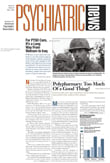Like other clinicians, I work to know and care for my patients and to avoid causing harm. Part of psychiatry is finding evidence for the success or failure of our efforts and determining whether the evidence is sound. This part—being a good epistemologist—is one of the hardest in medicine. We also hypothesize on the causes for clinical improvement, stasis, or decline. Amid this epistemological work, we also call forth empathy for our patients’ lives in their worlds and for their experiences as patients.
My father taught me much about empathy, especially while he was a patient. An Italian immigrant and gifted physician, two years of prison camp during World War II left him susceptible to later illness. Medical frailty eventually rendered him disabled and homebound his last 14 years.
I learned patient safety firsthand as our family shepherded my father through dozens of hospitalizations. He was often helped but sometimes (inadvertently) harmed, and he often received compassion but sometimes indifference or rudeness, until his death many years ago.
Five years ago I became a state psychiatric hospital’s medical director. One hat I wore was that of chair of the pharmacy and therapeutics committee. I’d blithely pass out data gathered by pharmacy and nursing staff, including the hospital’s medication error rate. For the nearly 40,000 monthly medications administered to patients, we would average 12 errors. Not too bad for a much-maligned state hospital!
After a while, the pharmacy director determined it was safe to express less-laudatory observations. I found we were sloppy epistemologists—medication errors (all self-reported, as in most hospitals) were never independently assessed for accuracy. Yet staff feared punishment for reporting their mistakes or others’, and administration did not protest low error rates, so self-reporting seemed suspect.
In seeking more valid data, we found 2,194 medication errors versus the nine errors staff had reported for the same patients and episodes of care. I began to wonder how exposed our patients were to medication errors.
Then I discovered that a patient safety movement had been spawned 20 years ago when mortality rates from anesthesia caused a spike in liability premiums. The mortality rate has been reduced from 1 in 10,000 to 1 in 200,000 (1). Brennan, Leape, Bates, and others in the Harvard Medical Practice Study later broke ground in medical error studies in the early 1990s (2,3).
Reports emerged of seemingly implausible patient death rates caused by errors. In its 1999 landmark report, the Institute of Medicine concluded that 44,000 to 98,000 persons die each year from medical errors (4). Harvard’s Lucian Leape argued that 180,000 people die each year as a result of treatment-induced injuries—the equivalent of three jumbo-jet crashes every two days. I became a proponent of the Institute of Medicine’s “10 Rules for Change,” enumerated in “Crossing the Quality Chasm,” especially the rule of transparency (5).
Like-minded colleagues and I created a patient safety institute in Maine (6) and a Web-based data collection system that allows staff from all U.S. hospitals to report medication errors and adverse drug reactions anonymously and to rate their hospital’s work culture regarding transparency, quality, and safety (7).
Today I’m still a full-time clinician. But the reports of widespread patient dissatisfaction and of many patients inadvertently harmed gnaw at me.
I think psychiatry should welcome the patient safety movement. Let’s consider the Institute of Medicine’s “10 Rules for Change” vis-à-vis psychiatry and ensure that our work is included in reports such as “Crossing the Quality Chasm” (5). APA’s efforts at pushing payers to value more highly our patients’ clinical needs and to reward clinicians for practicing good psychiatry deserve our support, as does APA’s Committee on Patient Safety. Fear of unjust malpractice litigation that deters adopting transparency must be allayed, perhaps partly by linking increased transparency with tort reform.
In the end, we remain well advised (although not in our Hippocratic Oath) by Hippocrates: “Above all [first] do no harm.” ▪
